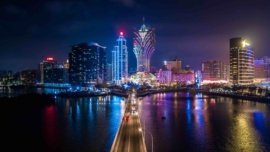As the government prepares to demolish 11 shipyards in Lai Chi Vun Village in Coloane, experts involved with the area development told Business Daily that very little has been done to preserve the historic structures since the government first presented a development plan for the area in 2012. However, they hope the future renovation preserves some of the historical importance of the remaining shipyards.
At the beginning of this year the Marine and Water Bureau (DSAMA) and the Land, Public Works and Transport Bureau (DSSOPT) announced that the shipyards located in 11 of the 18 land plots in the Lai Chi Vun area would be demolished due to the risk of collapse created by their advanced deterioration, with the two structures in worst condition to be demolished in March.
Tear them all down
According to José Sales Marques, President of the Institute of European Studies of Macau (IEEM), since the government presented its Coloane Old Urban Area Lai Chi Vun Planning Research in 2012 “many years passed” with no developments, with the government “suddenly” deciding to demolish the majority of the historical structures.
“After all these years we reached the conclusion that nothing has been done and that they have to be demolished. Luckily, they decided some shipyards won’t be destroyed (…) We can’t forget the shipyards are in the Lai Chi Vun area, which has its own residents’ association who many times requested their preservation; so the decision to demolish most of the shipyards comes to me as something hard to understand. Many observations were conducted in the past by the DSSOPT and architects from the IC, which said it wouldn’t be that hard to recover the shipyards,” Mr. Marques told Business Daily.
In 2013, the IEEM President conducted a competition with the Polytechnic Institute of Milan to create a proposal of renovation for the area, with Mr. Marques suggesting any future projects in the area focus on history preservation, such as a shipyards museum.
“It’s not a good end for this issue but since that’s how it is at least let’s make it so that future projects help remember the area’s history. There are people still alive that made the last boats constructed in Macau, naval experts that could help. We should also involve the residents and make it a cultural project that serves a purpose of cultural tourism, not make some kind of Disneyland for tourists calling it preservation. A knowledgeable tourist will always come to see attractions with authenticity,” he added
Decaying history
The land plots are part of 18 government units, the right of use of which were leased to different owners in the 1980’s and 1990’s, mainly to the shipbuilding industry.
According to a response sent by DSAMA to Business Daily, the licence owners were responsible for the maintenance and recovery of the shipyards while keeping the purpose of the lease, namely ‘ship building construction and repair, activities that were gradually abandoned.’
According to DSAMA ‘from 2013 to 2015, the department requested at least five times that the 11 temporary licence holders repair the shipyards as soon as possible.’
DSAMA claims that the occupants did not fulfil the responsibility to do so, causing the lack of long-term maintenance of the shipyards and risk of collapse. Thus, the renewal of exploration licence for those 11 shipyards was cancelled on December 31, 2015.
Following the collapse of a shipyard in April 2016 the government enclosed and reclaimed the shipyards area in risk of collapse and, of the seven remaining shipyards, four were considered to have the appropriate maintenance, with DSAMA saying their licence renewals were being considered.
Three of the these four shipyards are currently under the management of the Macau Cultural Affairs Bureau (IC), which told Business Daily it intends to consult the building owners in order to use them ‘as an interface to display the history of the shipyard area in Lai Chi Vun Village, to publicise the art and technique of the shipbuilding industry in Macau’ while retaining ‘parts of facilities remembering the history of the shipbuilding industry.’
Former IC Director Ung Vai Meng previously told TDM Radio that he “wasn’t consulted by the DSSOPT” with regard to the shipyards’ demolition and rejected the remaining shipyards to be preserved would be used for “commercial purposes” suggested in the 2012 study.
Secretary for Transport and Public Works Raimundo Arrais do Rosário also told TDM Radio that he had no knowledge if the 2012 study was to be maintained and that he hadn’t received any information regarding the study in the last two years.
Changing to smaller boats
Working in the shipbuilding industry since the 1970’s, Mr. Tam bought the rights of exploration of the Victory Shipyard in 1996, building fishing boats until he decided to cease activities in 2004.
“Before the 90’s there was a good market for it and in the past 80 per cent of the fishing boats in Hong Kong were made here. Then the fishing industry started declining mainly due to the opening of the Chinese market which increased competition and the overexploitation of fisheries in the region,” Mr. Tam told Business Daily.
With the fishing industry decaying, the shipbuilding industry where Mr. Tam worked followed suit and in 2006 the last ship was built in Lai Chi Vun.
After ceasing the work in his shipyard the building expert turned the space into a workshop for wooden boat replicas “in order to preserve the old Chinese junk building techniques.”
According to Mr. Tam, when he ceased shipbuilding activities he suggested to the government that the land be used to develop various projects, which the government did not agree to.
Since the shipyard no longer fulfilled its function for shipbuilding, the government declined to renew its licence and foreclosed it, with Mr. Tam now crafting his boat replicas in a neighbouring shipyard.
“I’ve been working in this area for many years so I wanted to redevelop my business here. Now the government says they just want to demolish [the yards] instead of helping the previous owners develop the buildings. I think the government should have a more precise plan before demolishing the shipyards. I think they’ll develop the area for different uses such as housing units while not keeping the shipyards,” he told Business Daily.
As good as new
For Carlos Marreiros, architect and President of the Architect Association of Macau, the Lai Chi Vun shipyards are part of Macau’s “invaluable” architectural and cultural history; he believes an “in-depth study” should be conducted for their revamp.
“I don’t know the government’s plan in detail but this area deserves to be preserved and the structures need to be consolidated (…) I can understand the government having valid reasons for not preserving some of the shipyards – some are in worse conditions than others – but the area deserves a rigorous study,” he told Business Daily.
The architect stated that although these structures are not made of “refined materials” they have their “own value” and could be reinforced with “possibly a minimalistic metallic structure” that would not distract from the shipyards’ “ambiance.”
Mr. Marreiros also suggested the creation of a museum itinerary enabling visitors to access different levels of the shipyards and access multimedia information of the region’s history and its past industry.
“I can’t imagine public housing or residences being built there; it should be cultural [facilities], a museum and other recreational [facilities] such as restaurants. If Macau wants to be a World Centre of Tourism we have to offer them more interesting attractions,” he said.
The architect also believes creating a marina could help the area become more dynamic by allowing access to recreational boats under the Free Yacht Travel Scheme or from other areas of the MSAR. In a response to Business Daily, DSAMA stated it currently had no plans to develop the area for such purposes.
—
Long ago
The Coloane Old Urban Area Lai Chi Vun Planning Research 2012 plan was developed in
co-operation between the DSSOPT, the IC and DSAMA and suggested a 5,000 square metre area in Lai Chi Vun Village could be revamped through the revitalisation of the ship construction industry heritage.
This would involve creating four zones: Zone A with a transit square for access in the village with an exhibition gallery of the shipyard; Zone B for a leisure area and gallery of lime factory exhibition; Zone C for a recreation area with exhibition areas of shipyards and locksmith factory, together with a cultural and creative area; and Zone D, to present the Chinese junk building industry.
According to DSSOPT’s recent response, following public consultation in 2013 the study was approved and will be used as a reference for future development of the area.
























